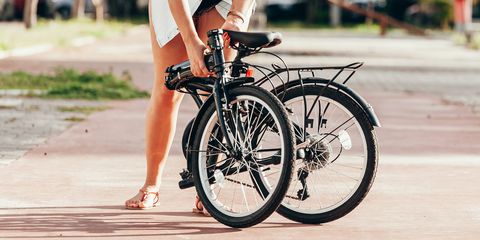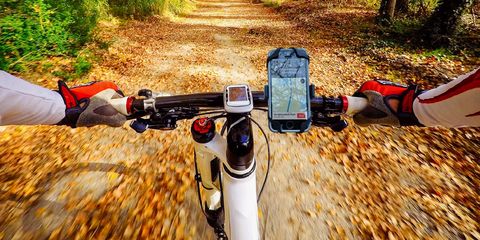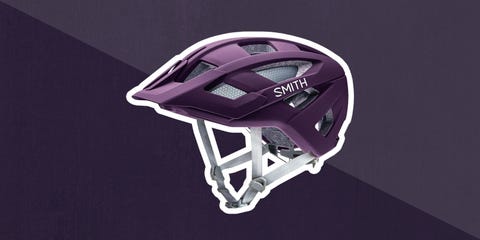Mountain biking is some serious fun, and it's gained tons of traction in recent years ! There are infinite reasons why people love mountain biking, but we'll just name a few: it's a never-ending challenge, it's outstanding for your cardiovascular health, it's a surefire way to cover more miles on the trails around town, it's an excellent way to build connections to people in your community, and best of all, it's a serious thrill!
Choosing the correct mountain bike can be a bit overwhelming because there is an insane amount of options, all with their own unique features. To help you make a choice, we are going to break things down as simply as possible, and we're going to focus on hardtail mountain bikes, only. Let us explain.
Q: What are the three main types of mountain bikes?
A: Mountain bikes can be classified in three main ways, based on their suspension (or lack thereof): rigid, hardtail, and full-suspension. A rigid bike has no suspension, so they aren't super practical if you intend to do much off-road riding. Hardtails have a front suspension fork, but no rear shocks (hence the name). They absorb impact well on the front wheel, but the lack of rear shocks means the ride can be a bit rougher on more technical terrain, so they aren’t ideal for downhill lift-serviced riding. Full-suspension bikes have both a front fork and a rear shock. They are some pretty badass machines, capable of raging on some seriously sketchy terrain. Entry-level full-suspension bikes start at $2,000 and can easily cost more than your car!
Q: Why should I choose a hardtail mountain bike over a different type?
A: Hardtails are the perfect middle ground for anyone looking to give the sport a try for a number of reasons. The front suspension fork can absorb impact on reasonably rough trails, while the “hardtail” rear provides a truer-feeling transfer of power. This simpler design means they are often a lot lighter in weight, and fewer parts means that maintenance is simple and there are fewer components that could malfunction. And last but not least: price. Hardtails can get pretty expensive, but it's not hard to find a solid bike from a reputable brand for less than $1,000.
Q: What else should I consider when buying a hardtail mountain bike (or any bike)?
A: Style of riding. Hardtails typically fall into one of two categories. Trail bikes are the most versatile option for uphill, downhill, and everything in-between. Cross-country bikes are lighter in weight, geared at riding fast for longer distances and climbing efficiency.
Wheel size. 26-inch wheels used to be the standard, but are slowly being phased out. 27.5-inch wheels are a great do-it-all size, but not for smaller riders. 29-inch wheels can handle gnarly terrain with ease, can ride fast, but take more effort to accelerate and are tougher to maneuver.
Frame materials. Aluminum alloy is the most common. Many other options exist (steel, carbon fiber, titanium), but hardtails under $1,000 typically are made of aluminum.
Gears. Having fewer gears works for flat terrain or for expert bikers. If you’re less experienced or ride lots of hills, you’ll appreciate the ability to switch gears to make steep hill climbs easier. It’s common for bikes to have a single chainring (the front gear set) with around 10 cogs on the cassette (the rear gear set), and many people tend to favor this setup. It's really a matter of personal preference, though.
Brakes. Disc brakes are the new norm, with pads that grab a brake rotor attached to the hub of the wheel. Hydraulic disc brakes are faster, more reliable, and more powerful. Rim brakes around the outer rim of the wheel are pretty outdated, especially for mountain biking.
Fit. Arguably the most important consideration is the bike's fit, because it doesn’t matter how skilled you are if you’re a large human trying to ride a child’s bike. Sizing a bike is its own science. Most bikes are offered in small, medium, and large, and sizing is pretty standard across manufacturers. Check the brand's size chart, and err on the small side if you’re between sizes, because adjustments can make the bike feel bigger, but won't make anything smaller.
Q: Why should we trust you?
A: These hardtail mountain bikes have all been carefully examined by our editors. To compile this list, we started with our firsthand knowledge of and experience with riding mountain bikes. We combined that with our understanding of the market, research on current trends, and surveys of user reviews. With our audience in mind, we have provided the most relevant suggestions based on value, quality, price, style, and overall fit.
However you ride, get your wheels spinning with one of this year's best hardtail mountain bikes, and prepare yourself to venture off-road for some dirt-kicking, mud-flinging fun (and exercise).
1
Best Bang For Your Buck
Trek Marlin 7 Hardtail Mountain Bike
- Excellent value
- High-quality RockShox suspension
- Available with 27.5- or 29-inch wheels
- Easy to upgrade
If you’re newer to the sport of mountain biking, but have intentions of racking up miles outside of town, and maybe even experimenting with some cross-country races, then make Trek’s Marlin 7 a top contender in your search. Trek built this hardtail with upgrades where it counts, like the RockShox XC 30 front suspension fork with 100 millimeters of travel and lockout capability, so it will absorb shock with ease when you want, but can be stiffened up to improve pedaling efficiency when energy-saving is a priority.
The Marlin 7 is available with 27.5-inch or 29-inch wheels, so there’s an option for riders of all shapes, sizes, and styles. Trek’s Alpha Silver aluminum frame is the ideal combination of tough and lightweight (without costing a fortune), so you'll feel lighter and faster, but won't end up bike-less if you smash it into a tree.
Since it’s well under the $1,000 limit, you'll have some extra cash in your pocket to add a dropper post (hydraulic adjustable seat post) or buy a badass lock to keep the onlookers at a distance. With the Trek logo stamped on the side of these sexy orange or silver frames, you’ve got the complete package for anyone looking to bike on a budget.
More: The 5 Best Bike Helmets for Safer Cycling
2
The Dark Horse
Diamondback Line Hardtail Mountain Bike
- Great value
- Shimano 9-Speed drivetrain
You may think of Diamondback as the brand that stocks the shelves in Target's sporting goods section — but they are so much more than that now! In the past few years, Diamondback has invaded the mountain biking world with some bikes that are somehow built with higher quality components than similarly priced competitors.
The Line is a pretty rad hardtail, with an aluminum alloy frame and progressive geometry, so riding is more comfortable, and risk-taking is less frightening. 27.5-inch wheels cruise on shaky trails, disc brakes stop on a dime, and the front fork’s 120 millimeters of travel absorbs some pretty sizable bumps.
We love the Shimano 1x9 drivetrain (single-chain ring in front, 9-gear cogset in back) for this hardtail, as it makes shifting super simple, taking some of the work out of hill climbing. Whoever said that a solid bike can't cost well under $1,000 hasn't ridden the Line.
More: 7 Best Rooftop Tents for Camping
3
Best 29-Incher
Orbea MX 10 29" Bike 2019
- 29-inch wheels are fast and stable
- High quality RockShox suspension
- Hydraulic disc brakes
- 29-inch wheels are too much for some riders
- Suspension only has 100 millimeters of travel
Orbea’s MX 10 is the only hardtail with 29-inch wheels in this list, which means it's faster and more stable on sketchy terrain than most. Just be absolutely sure that 29-inch wheels are the best choice for you, because they can be a bit tricky to maneuver for less aggressive or smaller riders.
This mountain bike slides right in at $999, and it's about as fully loaded as they come in the sub-$1,000 group. The MX 10's aluminum frame is lightweight and strong, internal cable routing gives a clean look and reduces maintenance, and hydraulic disc brakes stop faster than most cable-activated options. If you prefer a higher variety of gears, this 20-speed Shimano drivetrain (2x10) will impress. And while the front suspension fork has just 100 millimeters of travel (less than most on this list), it's made by RockShox — a tried-and-true brand that leads the industry in suspension performance.
More: 8 Best Reusable Water Bottles
4
Most Threatening
Marin San Quentin 1 2019
- Frame can fit larger wheels down the road
- Hydraulic disc brakes
- Front fork has 120 millimeters of travel
- Shimano 9-Speed drivetrain
- More aggressive style isn't for everyone
If the first thing that comes to mind when you hear San Quentin is California’s maximum-security prison, you are not alone! Marin Bikes (based in Marin County, California) named this bike after their roughest parts: the prison itself. The San Quentin 1 is a rough and rowdy all-mountain hardtail.
With big 27.5-inch wheels, 120 millimeters of travel in the front fork, and a more aggressive style than many hardtails, this bike is capable of a little bit of everything: downhill speed, long distances, and a dive into jumps!
The Shimano 1x9 drivetrain will make easy work of tall climbs, while hydraulic disc brakes, which are rather rare in this price range, will bring you to a screeching halt when the trail turns into a cliff. These tough components, coupled with a double-butted aluminum frame, are ready to go hard!
5
Most Fully Loaded
Rocky Mountain Growler
- Higher volume tires are more forgiving
- Shimano 9-speed drivetrain
- Front fork has 120 millimeters of travel
- Trail-oriented geometry is more aggressive
If you’re looking for a seriously capable off-roading machine with a $1,000 price cap, you’d be silly to overlook the Rocky Mountain Growler 20. The lightweight aluminum frame is simple, sturdy, and stable enough to feel solid while you’re pushing its limits and hold strong when you inevitably lay it down. The Growler features a trail-oriented geometry (less for cruising, more for charging) gives you the juice to push through steep uphills, fly over rollers, and charge hard to the finish line.
The Growler's 27.5-inch tires have a higher volume than many other tires in this range (3 inches versus a more common 2.3 inches), which provide more forgiveness and won’t punish you with a trip over the handlebars for small mistakes.
Additional features like disc brakes and a 120-millimeter front suspension are standard in this price point, while the Shimano 1x9 drivetrain helps this bike perform like many much more expensive counterparts.
Just let your friends know about the meeting spot ahead of time, because there’s a strong chance you’ll leave them in the dust.
6
Best for Bikepacking
Marin Pine Mountain Bike
- Rigid frame has a strong, confident feel
- No front fork to absorb bumps
The Pine Mountain is different from every other bike in this review, thanks to a steel frame and hard front fork. The 27.5-inch wheels feature plus-sized tires that bridge the gap between most mountain bike tires and a fat bike. Translation: More surface contact equates to better traction. These wheels are “tubeless-ready,” too, meaning you can upgrade easily to tubeless tires and worry less about flats when you’re miles from civilization.
This bike has a rigid frame, which means there is no front suspension. This can make technical downhills a bit more difficult, but the world is your oyster for daylong and overnight bikepacking adventures. Hydraulic disc brakes can stop this big rig if a rattle snake is stopped mid-trail, and the Shimano 1x10 drivetrain (again, one of a kind in this list) makes climbing fun. That’s right, we said climbing uphill can actually be fun!
7
Most Economical
Canondale Catalyst 3 27.5
- A more easygoing geometry is great for cruising
- Front fork only has 75 millimeters of travel
Coming in significantly less expensive than the other bikes in this list, this Canondale is more of an all-around cruiser than a hardcore mountain bike. The front suspension fork, with 75 millimeters of travel, is much smaller than the other bikes reviewed here, but it’s plenty capable of taking shortcuts on unpaved trails and hopping curbs.
Meanwhile, the tires are more casually studded, so they still grip loose terrain well, but they'll cruise better for smooth sailing in the city. Additional features, such as a lightweight aluminum frame, cable-controlled disc brakes (not hydraulic), a 21-speed drivetrain, and a competitive price point, make this a perfect entry-level mountain bike for anyone who rides frequently around town, takes some tow-path shortcuts, and ventures into the hills from time to time.
8
Co-op Cycles DRT 1.2 Bike
- 27-speed drivetrain is super versatile
- Internal cable routing is ready to upgrade to a hydraulic dropper seat post
- Front fork has 120 millimeters of travel
- Hydraulic disc brakes can be remotely locked out
- Too many gears can complicate things
REI’s own brand of gear is always solid and tends to be much more affordable than other big brands. By skipping the middle man, REI can offer good quality at a much better price. And this bike is no exception to that rule.
The Co-op Cycles DRT 1.2 hardtail mountain bike has a 3x9 drivetrain for a total of 27 gears, which provides tons of versatility on all types of pitches. 27.5-inch wheels, an aluminum frame, and 120-millimeters of travel in the front are pretty common in this price point. The cables (brakes, shifters) are routed inside the frame tube, which prevents them from snags and offers a much cleaner look. The disc brakes are hydraulic, and the low-profile rear derailleur is designed to minimize snags and bumps.
One feature we love is the ability to remotely lock the front fork (to stiffen it), which basically converts the bike to a rigid frame. This makes the bike more responsive, and minimizes the leg work required for steep uphill climbs, because saving energy is vital when you're on an all-day ride.
9
Giant Talon 27.5 Mountain Bike
- Affordable, yet capable
- 24-speed drivetrain is super versatile
- Front fork only has 100 millimeters of travel
Simple, affordable, and reliable, Giant’s 27.5-inch Talon is built for fun on singletrack trails and dirt roads. It may not be the fanciest option, but it also doesn’t claim to be.
The Talon features an aluminum alloy frame, a 100-millimeter front fork that reduces chatter on washed out forest roads, 27.5-inch wheels for speed and stability, and high-quality Maxxis tires that grip confidently. You’ll appreciate the 24-speed drivetrain (3x8), which gives you plenty of power for big climbs, yet allows you to switch things up and maintain speed when the trail flattens out. To experiment with off-road riding, the Talon is your ticket.
Andrew Bettlach
Andrew has been contributing to the outdoors and fitness content on BestProducts.com since 2017; he's a nature lover, peak-bagger, skier, and general good-time haver who lives in Colorado, knows where all the fresh snow is, and what gear you should be wearing for staying warm or looking fresh.
This content is created and maintained by a third party, and imported onto this page to help users provide their email addresses. You may be able to find more information about this and similar content at piano.io
























